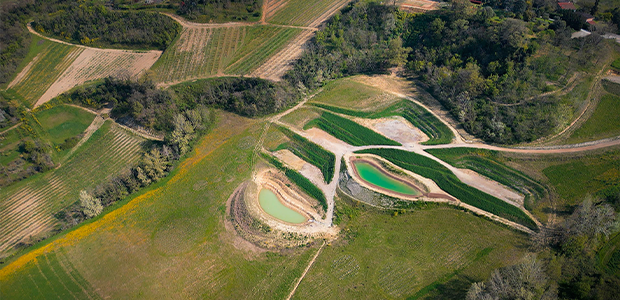
WASP launches Shamballa: Italy’s open-air lab for 3D printed sustainable living
In 2016, WASP first introduced the Shamballa project, inspired by the ideal of peace and harmony embodied in the legendary place of Tibetan tradition. The goal was ambitious: to turn that ideal into reality through the conscious use of an emerging technology: 3D printing. The project was conceived as a space dedicated to research, where 3D printing would be used to address the fundamental needs of human beings: food, housing, health, energy, work, and culture.
Guided by this vision, WASP has over time developed a range of technological solutions aimed at this purpose. Among them stands out Crane WASP, a construction 3D printer capable of using local, zero-kilometre natural materials, which has become a symbol of Italian innovation in the world of 3D printing for construction.
To fully harness the potential of its technology and establish its presence in the construction sector as a building company, WASP launched an innovative startup: WASP 3D Build, dedicated to 3D-printing construction using the very same Crane WASP.
The next chapter of Shamballa: a research and production laboratory for sustainable living
Nearly ten years after the project began, we are proud to present the next chapter of Shamballa: an eight-hectare space nestled in the hills of Northern Italy, where technological research, sustainable production, and shared experience come together.
The group’s investment of over €1,000,000 is a tangible sign of its dedication to the original vision that started the company: using technology to generate a positive impact on people and the environment. The project and land management are carried out by WASP 3D Build and Olfattiva, two companies within the CSP S.r.l. group based in Massa Lombarda, Ravenna, working respectively on the construction of the spaces and the enhancement and cultivation of the land.
At the heart of the project is the regeneration of a previously uncultivated farmland, transformed into a medicinal botanical garden through reforestation and agroforestry efforts. Over 500 fruit trees of ancient local varieties and 50,000 aromatic medicinal plants will be planted, contributing to increased biodiversity of both flora and fauna.
Shamballa is taking shape as the largest open-air laboratory where 3D printing becomes a tool for both production and research. The first structure to be built in this space will be Itaca: the first self-sufficient 3D-printed farm, inspired by an eco-sustainable housing model and supported by a circular micro-economy. Itaca is designed to ensure maximum autonomy in water, energy, and food, through the efficient use of natural resources.
Over the next three years, Shamballa will be enriched with new projects aimed at expanding the possibilities of 3D printing in the construction sector, with a particular focus on the use of natural materials. High energy-efficiency housing solutions will be developed, along with infrastructure such as rest areas and sanitary facilities, and micro-architectures dedicated to biodiversity protection, including shelters for insects and microfauna.
After more than two years of preparatory work, Shamballa is now in its final construction phase, with the opening scheduled for spring 2026. The first structures to be completed will be Itaca and a green-roofed conference hall, designed to host educational activities, public events, and collaborations with international partners.
For more startup news, check out the other articles on the website, and subscribe to the magazine for free. Listen to The Cereal Entrepreneur podcast for more interviews with entrepreneurs and big-hitters in the startup ecosystem.

